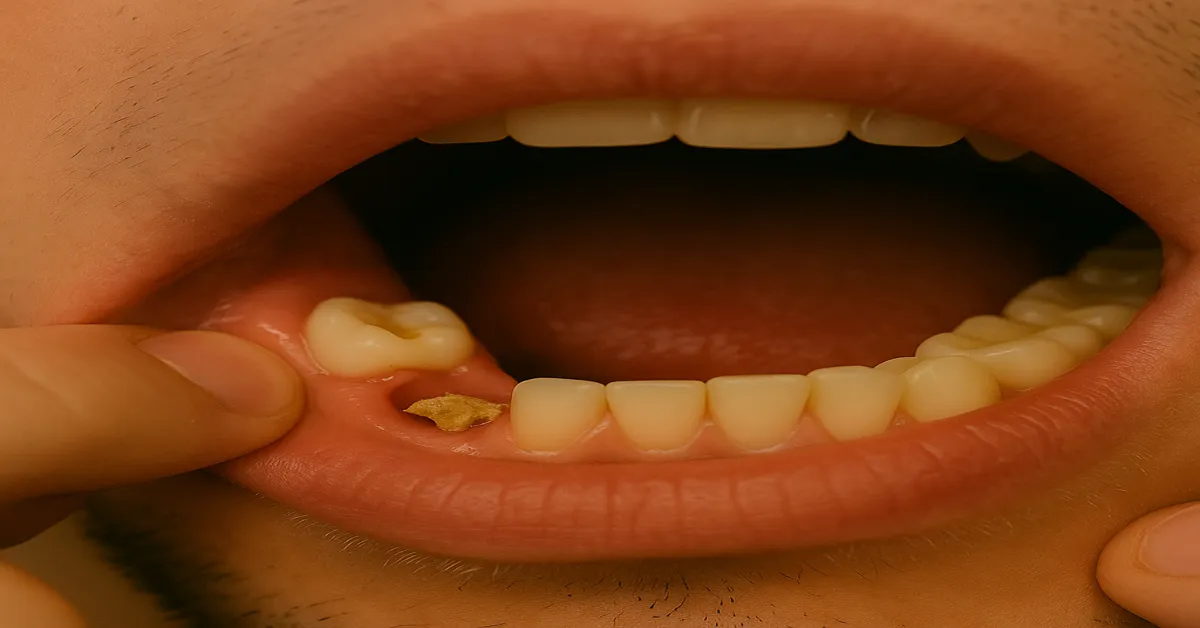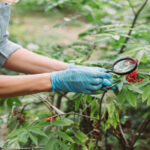If you’re searching for “food stuck in wisdom tooth hole,” chances are you’re recovering from a recent extraction and now facing one of the most common post-surgical annoyances. Perhaps it’s day two, or maybe you’re well into week one, but now you’re suddenly aware of something unpleasant: a grain of rice, a seed, or a tiny bit of sandwich seems to have settled deep in the extraction site. You’ve rinsed. You’ve worried. And now you’re wondering—is this dangerous?
This article is your definitive guide. It answers what’s normal, what’s risky, what you should do (and definitely not do), and how to keep the healing process on track without panic.
Why Food Gets Stuck in a Wisdom Tooth Hole
Let’s start with a basic reality: after a wisdom tooth extraction—especially of lower molars—you’re left with an open socket in your gum. This space is where the tooth once was, and depending on your age, extraction method, and healing rate, it can remain partially open for several days or even weeks.
During this time, it’s incredibly common for food particles to become trapped. The back of the mouth is hard to reach, and chewing naturally pushes debris toward the extraction sites.
Factors That Increase Risk of Food Impaction:
- Deep or wide extraction sockets
- Incomplete blood clot formation
- Soft foods like rice, noodles, or seeds
- Poor rinsing technique
- Infrequent oral hygiene during recovery
The result? A small but annoying impaction that can feel uncomfortable, or at worst, lead to infection or delayed healing.
Is It Dangerous to Have Food Stuck in the Socket?
Not always. In most cases, small food particles will either dissolve naturally or be dislodged with gentle rinsing. However, prolonged food impaction may increase the risk of:
- Infection
- Foul odor or taste
- Inflammation
- Delayed healing
- Dry socket (if the clot is dislodged improperly)
Signs That Require Prompt Attention:
- Persistent bad breath or taste despite rinsing
- Visible pus or white material leaking from the hole
- Increasing pain after several days of improvement
- Swelling that worsens
- Fever or general malaise
In these cases, contact your dentist or oral surgeon. For mild cases, read on for safe at-home strategies.
What You Should NOT Do
In the anxiety of post-extraction discomfort, many people reach for whatever tool or method they can to “dig out” the debris. That’s a mistake. Certain methods can harm the clot, introduce bacteria, or delay tissue formation.
Avoid the following:
- Toothpicks or pointed objects
- Electric toothbrushes near the socket
- Forceful spitting or swishing
- High-pressure syringes unless advised by your dentist
- Using your finger or fingernails
- Floss threaders or straws
Even gentle-looking tools can damage the fragile clot or introduce bacteria, leading to dry socket—a painful condition requiring medical intervention.
Safe Ways to Remove Food Stuck in a Wisdom Tooth Hole
Now, let’s focus on what you can do. These methods are safe, recommended, and widely used by dental professionals for minor food impaction in healing extraction sites.
1. Saltwater Rinse (Gentle)
Mix 1/2 teaspoon of non-iodized salt in a cup of warm water. Gently rinse your mouth and let the solution soak in the affected area for 30 seconds before letting it dribble out.
Do this 2–3 times per day, especially after meals. This method helps dislodge debris and prevents bacterial buildup.
2. Warm Water Soak (No Swishing)
Hold warm water in your mouth for 60 seconds and lean your head toward the affected side. Let gravity help move the particle out without forceful swishing.
3. Oral Irrigation (When Cleared by Your Dentist)
After a few days (typically day 5–7), your dentist may recommend using a plastic curved-tip syringe to gently flush out the socket with warm saline.
How to use:
- Fill the syringe with saltwater
- Angle the tip parallel to the socket, not directly downward
- Gently flush after meals
This method is often provided and taught by your surgeon at a follow-up appointment.
4. Soft Brushing Around the Socket
After day 3 or 4, gently brush near the extraction site with a very soft toothbrush, avoiding the socket itself. This helps prevent food from getting pushed deeper.
How Long Does the Hole Stay Open?
Healing time depends on several factors:
| Factor | Influence on Healing |
|---|---|
| Age | Older patients may heal more slowly |
| Surgical method | More invasive extractions take longer |
| Clot stability | Dislodged clots slow healing |
| Smoking | Greatly delays closure |
| General health | Diabetes or autoimmune issues may delay recovery |
Typical healing timeline:
| Time Post-Extraction | What to Expect |
|---|---|
| Day 1–2 | Clot forms, mild bleeding, swelling |
| Day 3–5 | Pain decreases, socket still open |
| Day 6–10 | Tissue begins filling socket |
| Week 2–3 | Hole begins closing, food impaction decreases |
| Week 4–6 | Nearly closed in most cases |
Foods to Avoid During Healing
Even if you’re eating “soft foods,” some of them can easily get lodged in the socket.
Avoid:
- Rice and quinoa (small, sticky grains)
- Seeds and nuts
- Chips or crunchy foods
- Sticky bread
- Peas or corn kernels
Instead, opt for:
- Mashed potatoes
- Smooth yogurt
- Applesauce
- Soft scrambled eggs
- Blended soups
- Oatmeal (with caution after the first week)
Always rinse gently after meals, no matter how soft the food.
Preventing Future Impaction: Smart Practices
Once food gets stuck once, it’s more likely to happen again—unless you take proactive steps.
Practical Tips:
- Rinse thoroughly after every meal
- Use an oral irrigator once your surgeon approves it
- Brush your tongue and cheeks to reduce bacterial buildup
- Sleep with your head slightly elevated the first few nights
- Stick to liquid or blended meals the first 3–4 days
Optional: Clot Protectors
Some oral surgeons provide a temporary soft dressing or gauze pad that can be gently placed over the socket during meals and removed after. This protects the area during the most vulnerable stages.
What Is a Dry Socket—And How Is It Different?
Dry socket (alveolar osteitis) occurs when the protective blood clot is lost from the extraction site, exposing bone and nerves underneath.
This is not the same as having food stuck, but food impaction can contribute to developing a dry socket if removal attempts dislodge the clot.
Signs of Dry Socket:
- Sharp, radiating pain 3–5 days post-surgery
- Pain that worsens, rather than improves
- Bad taste and smell from socket
- Visible bone in the socket
- Pain not relieved by over-the-counter meds
If you suspect dry socket, contact your dentist. They may clean the site and apply a medicated dressing to ease discomfort.
When to Call Your Dentist
While most food impaction cases are minor, the following symptoms warrant a professional evaluation:
- Pain that worsens after day 3
- Swelling beyond day 5
- Fever or chills
- Bleeding that doesn’t stop with gauze and pressure
- Difficulty opening your mouth or swallowing
- Visible pus or unusual discharge
When in doubt, always consult the clinic that performed your extraction.
Final Thoughts: Patience and Prevention
Having food stuck in your wisdom tooth hole is annoying, not uncommon, and usually not dangerous if handled correctly. The most important response is gentle care, consistent hygiene, and resisting the urge to poke or prod.
As the socket heals and tissue regenerates, food impaction becomes less likely. But for the first couple of weeks, it’s wise to think like a surgeon: protect the site, keep it clean, and avoid unnecessary interference.
In a few more days, the socket will be smaller, the meals more varied, and the awkwardness of eating with surgical sites behind you. Until then, a little extra care goes a long way.
FAQs
1. Is it normal to get food stuck in a wisdom tooth hole after extraction?
Yes. It’s very common for small food particles to get trapped in the extraction site during the first couple of weeks, especially in lower molars. This happens because the socket remains open while healing and sits at the back of the mouth where food collects more easily.
2. What’s the safest way to remove food from the socket?
Start with a gentle saltwater rinse or hold warm water in your mouth over the socket. If your dentist has approved it, use a curved-tip syringe to gently flush the area. Never use sharp objects, forceful swishing, or your fingers.
3. Can food in the socket cause an infection?
If left in place for too long, trapped food can harbor bacteria and increase the risk of infection or inflammation. Signs include bad breath, swelling, or pus. Most minor debris clears with gentle rinsing, but persistent symptoms should be evaluated by a dentist.
4. How long does it take for the wisdom tooth hole to close?
Healing varies, but most extraction sites partially close in 1–2 weeks and fully close by 4–6 weeks. The risk of food getting stuck decreases significantly as soft tissue fills in the socket.
5. Should I avoid certain foods while my extraction site is healing?
Yes. Avoid small grains (like rice), seeds, nuts, and crunchy or sticky foods that can easily lodge in the socket. Stick to soft, smooth foods and rinse gently after every meal to minimize the chance of impaction.











